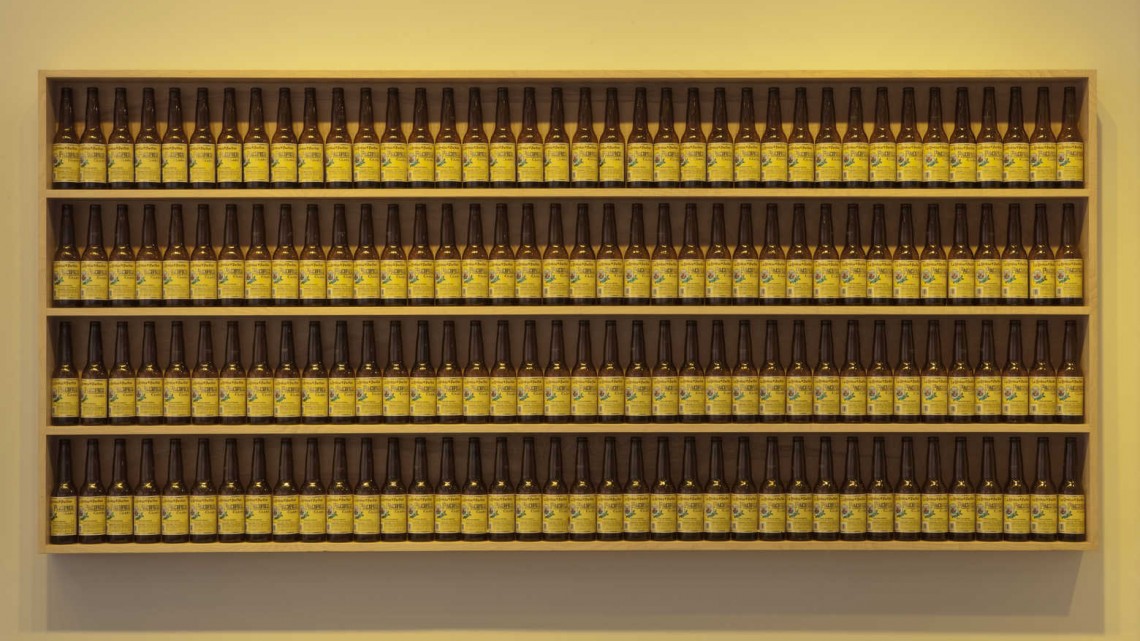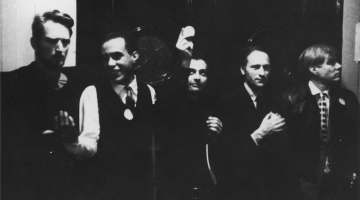Presented at Ever Gold Gallery, San Francisco, 2013 (Edited)
I’m going to tell some stories off the top of my head—is this thing on? Okay. All right.
Some of these stories are in my book, Beer, Art and Philosophy. It’s available at Crown Point Press and on Amazon. At the end of the evening, tonight, I will sell this autographed copy for $20.
There’s one more seat up here in front. Let’s see. I’ll take you. Come up and take this seat up here.
This year is the hundredth anniversary of the famous Armory Show in New York City, 1913—it was the first time that the word avant-garde was used, and it was the first time Americans had seen modern art. They had Gauguin and Van Gogh, Picasso, Matisse, and Marcel Duchamp. That’s where Duchamp showed his famous Nude Descending a Staircase, which one critic referred to as “an explosion in a shingle factory,” and it was a big scandal.
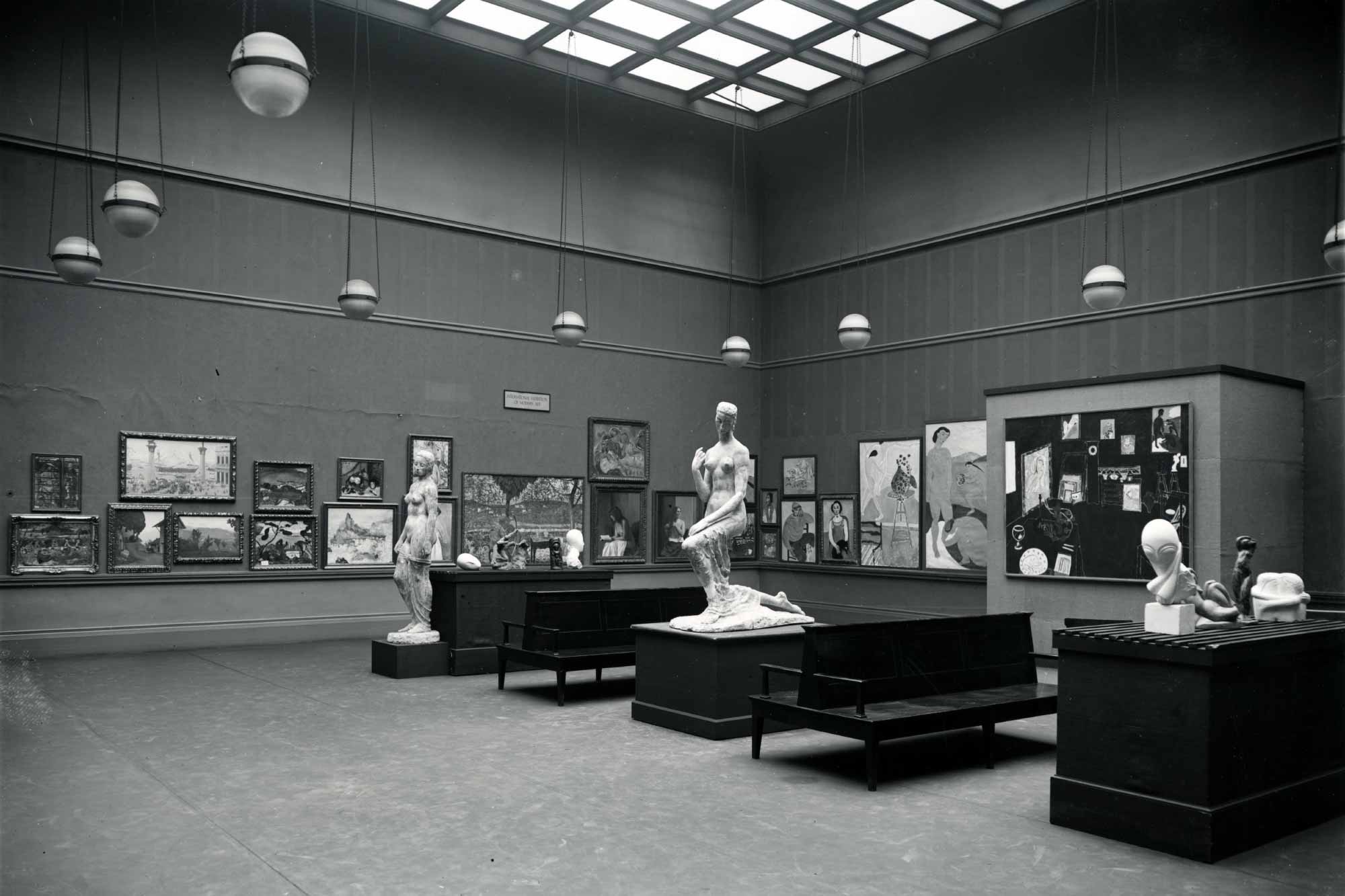
The Armory Show, New York, 1913. Installation view, including sculptures by Lehmbruck at front, smaller sculptures by Gauguin, Brancusi, Archipenko, and Bourdelle on pedestals, Matisse paintings along the wall at right, and paintings by Girieud, Charmy, Bonnard, Vallotton, and Chabaud along the wall at left.
A guy named Frederick C. Torrey, who was an art dealer in San Francisco, had a gallery at 550 Sutter Street. He sold antiques and Japanese prints. Torrey went to the Armory Show in New York and he bought Duchamp’s Nude Descending a Staircase and brought it back to San Francisco. He paid $324 for it, which, in today’s money, is about $5,500.
He had that painting for years and showed it in his gallery, and also he loaned it out and it traveled around. And then in the 1970s the Reese Palley Gallery was in the same space. It showed all the conceptual artists, Bruce Nauman, Terry Fox, Paul Kos, me, and other conceptual artists of the period—mostly California artists. I lived in that gallery for a whole week, as a project, and I had my first LSD experience. That was the first and last time I had an LSD experience.
Sometime in the ‘70s, the Reese Palley Gallery went out of business and another gallery moved in there at 550 Sutter Street. I can’t remember the name of it. They had an opening of Andy Warhol’s paintings. Warhol came to the opening, and brought Carol Doda with him as his date—she’s the topless dancer from North Beach. They arrived in a limousine and all the news media were there out on the sidewalk. Warhol entered the gallery with Carol Doda and then they separated. It was just about his entrance.
Terry Fox got drunk at the opening, and in the back hall there was a line waiting to get in the bathrooms, so he peed into one of the empty paint buckets there and was escorted out by a guard, in front of everybody including Andy Warhol. He went on the wagon for six months after that.
Today, 550 Sutter Street is the Craft and Design Museum. I went in there about a year ago. I told them these stories and they had no idea that the space had a history with Duchamp’s Nude Descending a Staircase or Andy Warhol’s opening with Carol Doda.
All those who believe in telekinesis raise my hand.
I don’t know if you all know this, but I founded the Museum of Conceptual Art. It was the first alternative art space in the country, and I organized some of the first conceptual art shows and the first video art show in California, the first sound sculpture show anywhere, and a lot of ground-breaking shows. I was in the peace and freedom party, I supported artists, and I am an artist myself. And do you think I’m known for that? You fuck one sheep . . .
In 1970, I went to Los Angeles and there was a dinner at Irving Blum’s house for Jasper Johns. I was visiting Larry Bell and Larry had been invited to the dinner. Irving Blum is the guy who had the Ferus Gallery, a famous gallery in Los Angeles at that time. I told a story at the dinner. I said, “The guy I used to work with, Hayward King, who was the director of the Richmond Art Center when I was curator there, had a boyfriend in Paris who was a curator at the Louvre Museum. Hayward used to go to Paris every summer. The Louvre curator told him that the Mona Lisa on exhibit was not the real thing. It was a copy, because in 1911 the painting was stolen by an Italian and brought to Italy for three years. It was recovered, but there have been other attempts to steal it or deface it over the years, so they kept the copy on display.”
I told this story to Jasper Johns and everybody at the dinner. Then I asked Johns, “Have there ever been any fakes, any copies of your paintings?” and he said, “Impossible.”
In 1975 I was the founding editor of an art journal called Vision published by Crown Point Press. We did five issues: California, Eastern Europe, New York City, Artists’ Talks, and Artists’ Photographs. That was the last one, 1981. For the Eastern Europe and New York issues I went to the places and visited artists in order to collect material. For the New York issue, every artist got six pages. I went to Carl Andre’s penthouse apartment—he was living with an art dealer at the time. He was a famous artist and a Marxist, and there he was in his overalls in this penthouse.
I went the next day to meet with Walter De Maria. He did The Lightning Field in New Mexico. We went to lunch at an Italian restaurant—I had spinach ravioli and he had veal piccata. He said, “Where are you going next?” I said, “I’m going to see Sol LeWitt.” I already knew Sol but they had never met. Imagine that—and they lived three blocks from each other. It was in the Little Italy part of New York. We went to Sol’s studio together, and I happened to have a joint with me. The three of us got stoned in Sol’s studio, and that was one of the high experiences of my life.
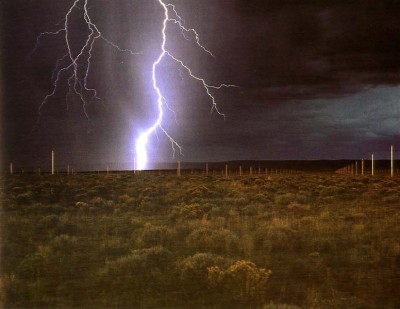
Walter De Maria, The Lightning Field, 1977. Long-term installation, western New Mexico. Commissioned and maintained by Dia Art Foundation.
In 1980 there was a gallery in Naples, Italy, run by Lucio Amelio. It was the hippest gallery in Italy, and he had invited Andy Warhol and Joseph Beuys to have a show. At that time Warhol was the most famous American artist, and Beuys was the most famous European artist. Beuys had his usual felt and fat and his organic materials. He did art about generating electricity, power, heat, and light—things like that. Beuys’s art was all about curious materials.
Warhol had done portraits of Joseph Beuys in diamond dust, as negatives. They were black on white portraits of his head. The German press referred to Beuys as “the man with the hat.”
Warhol and Beuys were both at the opening, and it turned out to be like a heavyweight championship between the American and the European. But Beuys lost to Warhol because Warhol, clever as he was, appropriated Beuys and made him the subject of his work for the show.
Then Warhol went on Italian television, where the interviewer asked him, “Are there any Italian artists that you’re interested in?” And Warhol replied, “There aren’t any artists in Italy. Maybe Giorgio Armani.” He was insulting to the Italians.
Sometime in the ‘90s, the Goethe Institute in San Francisco organized a music festival, and they asked me to be part of it. I was known as a sound artist as well as a performance artist back in the ‘70s. The Hawthorne Lane restaurant, which was next door to my studio, let me use their space; they had a baby grand piano in there. First, I conducted my Beer Drinking Sonata for 13 Players—the players drink beer and blow in the bottles after each swig. After that, at the piano, Steve Goldstein performed John Cage’s famous 4’33”. It’s in three parts, making up four minutes and 33 seconds of silence. About a minute into this piece, I heard a woman whisper, “I still can’t hear anything.”
Something happened to me recently that many artists have experienced. I was included in a group show in a museum dedicated to food, drink, and art that was founded by a big winery in Napa, California. My work, Golden Rectangle, was a shelf unit filled with empty beer bottles with yellow labels and designed to be lighted with two yellow spotlights. After I saw the show, I sent the following email message to the curator: “I think you forgot the yellow lights on my work.”
He emailed me back: “We didn’t quite forget the yellow light. In fact, it was a conscious decision not to use it. We felt that Golden Rectangle already looked so good and was such a draw to visitors who see it through the gallery door that we would actually lessen the impact with a yellow light. I intended to call you to discuss our thoughts, but I’m afraid my mind moved on to future exhibitions. I do hope you will not feel that we interfered with your concept. Our intention is always to present works of art to their maximum advantage. We are pleased and honored to have your work included in the exhibition, and I hope we will have future opportunities to bring you and your work to our museum.”
I emailed him back with this message: “The yellow light was not an afterthought. Many of my sculptures are lighted with yellow light. It’s a signature with me. Did you light it with yellow light and then decide it looked better without it?
The work looks good the way it is, but it looks better with the yellow light, the way I intended it. I understand the lighting is usually the job of the installer, but in this case the yellow light is a component of the piece. It’s not the job of the curator to change an artwork to try to improve it. But don’t feel bad, it happens to me all the time.”
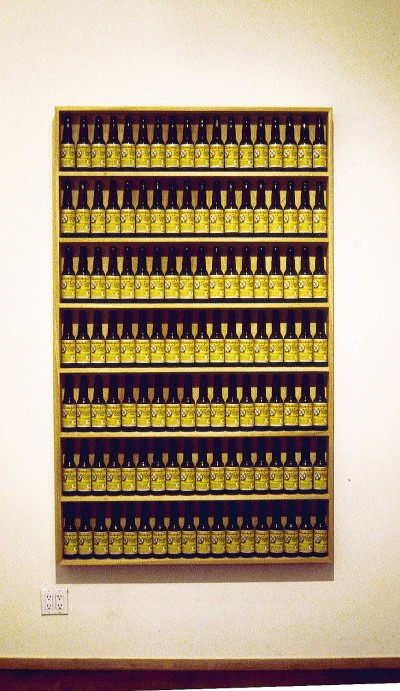
Tom Marioni, Golden Rectangle, 2000. 7 shelves of Pacifico beer bottles, 80 x 51 x 8 inches.
In the early ‘70s, I knew Robert Crumb slightly. For the last twenty years he’s lived in the south of France, but in the ‘70s he lived in San Francisco with two women, Kathy Goodell and Dotty Reed. They were sort of the basis for the characters in his cartoons—Kathy always wore boots and she looked just like the main female character. So I’m walking down the street in North Beach and a car drives by and Kathy hollers out the window, “Hey, Tom,” and they wave to me. And Crumb said to them, “Why do you want to wave to that WOP pimp for?” I actually felt flattered later when I heard about that from Kathy, because I thought, “I almost became a character in one of his comics.”
Mickey Mouse hired a psychiatrist to check up on Minnie Mouse, and a week later the psychiatrist says to Mickey Mouse, “You know, I think you’re right. Minnie Mouse is crazy.” And Mickey says, “No, I didn’t say she was crazy. I said she was fucking Goofy.”
Mel Bochner is a conceptual artist of my generation. I’m going to give you an idea about the prejudice that New Yorkers have about California—like when Woody Allen said, “The only advantage to living in California is that you can make a right- hand turn on a red light.”
Mel Bochner said to me, “Larry Bell is just Sol LeWitt with color.” Larry Bell was doing beautiful glass boxes that had slight color on them, and Sol LeWitt was doing kind of cubed open space objects. That was a put down, because “California’s just about color.”
In 1968 I went to the Monterey Jazz Festival with Alvie Lersen, a Cincinnati friend. We are driving around late at night—it is midnight and we see a diner. As we’re driving, I see this red Ferrari. And it’s Miles Davis. He is with another guy. I say, “Follow that car.” We stop at the diner, we go in, and Miles Davis is sitting down at the counter. I sit on the next stool. On the other side next to him is the other guy, one of his musicians.
I sat down and thought, “Oh, my God. Here’s my chance to talk to Miles Davis.” And I knew that if I were to talk to him, he would put me down, or he would just say, “So what?” Because that’s what he used to say to fans. He even wrote a song called So What.
I said, “Excuse me, do you have a light?” And he handed me a pack of matches without even looking. I lit my cigarette, said “thanks, man,” and I handed him the pack of matches. His friend next to him said, “What do you want to give that honky a light for?” And Miles said, “Shut up.”
I visited Chuck Close one time in New York in his studio and he was working on a painting of April Gornik. She’s a great painter and a great beauty. She’s got big full lips, and she’s just like a movie star, she’s so beautiful. Chuck Close says, “You see those lips? That’s $60 worth of cadmium red.”
This is a story that I heard Lenny Bruce tell; I saw Lenny Bruce twice back in the ‘60s. This guy’s in a hotel room and it’s late at night and he’s got a friend with him and they’re sharing a room. There’s a sink in the room, and the bathroom’s down the hall. So, the guy gets up in the night and he’s starting to piss in the sink. His friend wakes up and says, “What are you doing? I hope you’re not pissing in the sink.”
The guy says, “Oh no, I was just washing my leg.” So the friend says, “Well, you better not.” The guy still has to pee and he can’t go down the hall—he’s not dressed—so he goes out on the ledge. He’s going to piss outside the window. After he goes out on the ledge of the window, the fire engines pull up and then the police are there with speakers and lights. And they’re saying, “Stay there.” They call a priest, and the priest is on the megaphone and he says, “Don’t do it my son.” And the guy says, “I just gotta pee.” The guy’s mother is there, and she tells the firemen, “Run the hoses, run the hoses.” Then he says, “I can’t go now, with all of you looking.”
I was in New York and my wife and I were visiting John Cage. I was lucky to know Cage, and we went into this kind of organic restaurant and there’s Teeny Duchamp, Marcel Duchamp’s widow. He introduces us to her and that’s how I met her. I didn’t know at the time that she was from Cincinnati like me, or I would have asked her about that. Then, that night, we went to dinner at Cage’s loft where he was making dinner for Louise Nevelson. It was her birthday, and John says to her, “How old are you today?” Louise Nevelson says, “I’m 80.” He says, “Oh, that’s marvelous. I can’t wait till I’m 80.” John Cage died two weeks before his eightieth birthday, about 10 years later.
Charlie Chaplin goes to visit Picasso and he doesn’t speak French, and Picasso doesn’t speak English. Picasso was a big fan of Charlie Chaplin, and vice versa. Picasso pulls out all his paintings to show Chaplin. After that, Chaplin goes into Picasso’s bathroom and takes out Picasso’s shaving cream, soaps up his face, and shaves for Picasso.
The comedian Jonathan Winters was a Sunday painter, and he had a show in a gallery. Somebody came up to him and said, “You know, if you weren’t Jonathan Winters nobody would pay $10,000 for that painting.” And he says, “But I am Jonathan Winters.”
Bertrand Russell was giving a lecture on the origin of the universe and he said, “Nobody knows the origin.” And a woman puts up her hand and she says, “I know the answer.” And he says, “What is it?” And she says, “The universe is resting on a turtle.” And he says, “Well, what’s the turtle resting on?” And she says, “It’s turtles all the way down.”
An artist comes home and he finds his house has burned down. And he asks the fireman, “What happened?” And the fireman says, “The museum director came to your house, murdered your family, and burned your house down.” And he says, “You mean the museum director came to my house?”
In the ‘70s I was down in LA visiting John Coplans, who had been curator of the Pasadena Museum and was then editor of Artforum magazine. He got together with me and Irving Blum, from the Ferus Gallery. We had lunch and they said to me, “We want you to move your Museum of Conceptual Art to Los Angeles.” I went to a party that night at Coplans’s house. He had a fluorescent light tube on his wall, and I said, “Wow. Far out. He’s got a Dan Flavin in his house.” And somebody said, “That’s not a Flavin. It’s just a light he bought.” And everybody was swimming nude in the swimming pool out back. That was LA in the ‘70s.
1970 was the first time I did the piece that I’m most known for, The Act of Drinking Beer with Friends is the Highest Form of Art. I proposed it to the Museum of Contemporary Art in Chicago, and they said, “We’ll do it.” But the president of the board nixed it later, even after it was already announced in their museum newsletter.
Then I went to Gerald Nordland, director of the San Francisco Museum of Modern Art, and asked him if I could do the Beer with Friends work there, and he said, “We never present anything in this museum until it’s at least five years old.” That was a rule he just made up on the spot.
Then I went to the Oakland Museum and I asked George Neubert, who was the curator, and George couldn’t say no because the year before when I was curator at the Richmond Art Center I had done a show called Invisible Painting and Sculpture, and George was in that show. He was a graduate student at Mills College at the time. Later he got the job as curator at the Oakland Museum. That’s how I got to do my Beer with Friends in the Oakland Museum in 1970.
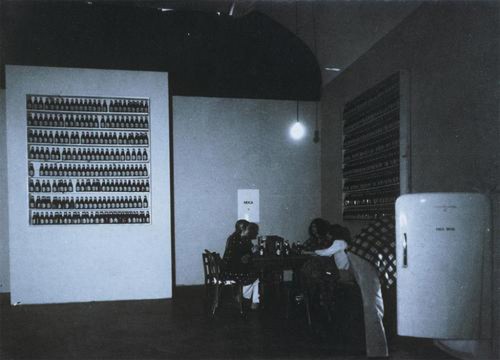
Tom Marioni, The Act of Drinking Beer with Friends is the Highest Form of Art, 1970-1979. Installation view, Oakland Museum of California. Collection of San Francisco Museum of Modern Art. Photograph by Dan Herth.
Sometime in the ‘70s, a psychologist from Canada who had written a book on architects using the Rorschach test came to San Francisco. She said she wanted to do a book on artists, so she gave me the test and I looked at the cards. They’re really kind of thick, and they have rounded corners. I looked at them and turned them over to see the back, and it said, “Printed in Switzerland.” I was curious, but I wasn’t interpreting. I was supposed to see spiders and vaginas in the images. Instead, I was interested in how the cards were made. It turns out Rorschach made hundreds of inkblots and then selected eleven of them and, the psychologist said, “The seventh one is how you see a woman.” Rorschach had it all figured out. I said, “I’d like to make an exhibition of these cards.” We were sitting in Breen’s Bar, which was downstairs from my Museum of Conceptual Art. “Oh, you could never do that,” she said. “If the images became familiar, then they wouldn’t have their power.”
A guy goes to a doctor and he says, “I have five penises.” The doctor says, “How do your pants fit?” And he says, “Like a glove.”
